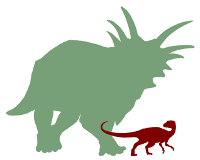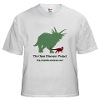The project is really rolling now – we have 46 project volunteers, 128 132 verified data entries and 46 56 unverified entries. Around 12 of the volunteers (representing several different countries) have submitted data, thus qualifying them for authorship. Thank you to everyone for your assistance, and your patience as we work the kinks out of the system. Several people have written in with some very helpful suggestions and requests for clarification, and some of those will be the topic of this post. Don’t be afraid to speak up, by email to me or in the comment threads! Unless we know there’s a problem or bit of confusion (no matter how slight), we can’t take steps to fix it. Really, our feelings won’t be hurt. And there’s no such thing as a stupid question.
Clarifying Some Measurements
Although we’ll have a larger tutorial on the forelimb in just a few days, I wanted to briefly discuss the scapula, coracoid, and scapulocoracoid (illustrated below). The scapula is the shoulder blade, and the coracoid is a bone that attaches to it. When the two bones fuse up (as often happens in dinosaurs), this single element is called a “scapulocoracoid.” Now, we have entries for scapula length (a maximum length of the element) and scapulocoracoid length (another maximum length), but not coracoid length. The reason for this is that almost nobody measures coracoid length the same way – some measure along the long axis, some along the axis parallel to the scapula. Because the consistency of measurements is especially questionable, we have elected not to include the coracoid in our measurement list.
Also, scapulocoracoid length is NOT the same as adding the lengths of the scapula and coracoid. See the diagram below for a reason why. In the example shown here, adding scapula and coracoid lengths together would slightly exceed the true measurement of scapulocoracoid length.

Scapulocoracoid of Triceratops in lateral (side) view (after Hatcher et al. 1907), showing one way to measure scapula length (1), coracoid length (2) and scapulocoracoid length (3). Note that 1+2 does not equal 3.
Our second point of clarification concerns the femoral measurements. On the spreadsheet as it was originally posted, we have length (L), minimum (or midshaft) circumference (Circ), mediolateral width at midshaft (Shaft W), and antero-posterior width at midshaft (Shaft L). Of course, the last two measurements in particular were very confusing as named. My bad. In particular, Shaft L implied a measurement very close to just plain-old length. These measurements are patterned after measurements taken by Matt Carrano, for documenting changes in femoral anatomy through dinosaur evolution. In order to avoid confusion in the future, I have now changed the column labels to Midshaft ML W and Midshaft AP L. Does this work for everyone?

Triceratops femur (after Hatcher et al., 1907) in anterior (front) view, showing 1) maximum femur length; and 2) mid-shaft mediolateral width (Midshaft ML W). Mid-shaft antero-posterior length would be perpendicular to #2.
For Those Who Are Measuring Specimens Directly
A brief note on this now, and we’ll hopefully have a more formal tutorial later. Whenever possible, we want maximum lengths of elements. Yes, we realize that this may mean slightly different anatomical landmarks on different taxa. For the present purposes of the study (and given the relative lack of standardization in overall anatomical measurements for dinosaurs), it is presumably just easier this way. Perhaps there is an interesting discussion to be had on standardizing morphometric measurements for archosaurs, though! Thinking out loud (this is an open project, after all), that would be a pretty darned cool product from the ODP. I know that some studies (Chinnery’s work on ceratopsians, for instance) have developed standard landmarks for a subset of archosaurs. . .has anyone attempted this for archosaurs as a whole? Or attempted to develop measurements that could be compared adequately with mammals?
And Don’t Forget
When you submit data, please make sure to provide a full reference for the paper in PLoS ONE format (see here for info), and include the page number for the data that you are transcribing. This will make it easier to check or double-check entries if there is a problem. Thanks!
Also, please make sure that someone hasn’t entered or re-entered the data you have your eye on. Always use the latest versions of the verification list and task list.
Looking For References? Check out the Polyglot Paleontologist! They’ve got lots of translations of dinosaur-related papers.



There’s an excellent ODP article by Jeff Martz over on Paleo Errata, pointing out the need for just this kind of thing. (Jeff’s always worth reading, he’s a funny guy — not many palaeo blogs consistently make me laugh out loud).
http://paleoerrata.blogspot.com/2009/09/open-dinosaur-project.html
question about the references. Should the full citations of the papers be sent to you Andy or added into the ODP bibliography wiki directly?
I thought participants were supposed to take measurements only directly from the tables or text.
Cheers,
Nick
Send the citation to me when you send the data, and also add them into the bibliography wiki.
From the FAQ:
So, it’s ok to take measurements first-hand from specimens. The only thing we want to discourage (and there’s not a lot we’re discouraging with this project) is trying to calculate measurements from photographs or drawings, because the scale bars and scaling statements associated with published illustrations aren’t always accurate.
One more (stupid) question – is there any consideration during data entry or analysis on the effect of ontogeny? For instance, juvenile tyrannosaur hindlimb proportions may be mistaken for ornithomimids. Is there similar confusion in this database?
This is actually a very good question, and not a stupid one. In terms of data entry, everything is going into the database, and I think it will stay that way for the time being (more data = good).
For the eventual analysis, I am thinking we will want to toss out juveniles (or at least tiny juveniles) from the statistical sample, for exactly the reasons you mention. Hadrosaurs are particularly rife with juvenile specimens.
Andy – don’t be so quick to toss out juveniles. For the subset of taxa where you have a good sampling through ontogeny, it would be really interesting to compare the slopes of the regression lines for quadrupedal vs. bipedal taxa.
I guess I should have been more specific – for the overall, comprehensive analysis looking at trends and patterns of limb proportions across all of Ornithischia, we will want to remove juveniles from that sample. As a supplement to that analysis, I agree that a comparison of regression lines for quadrupedal vs. bipedal taxa would be interesting (something similar to what was done for Dryosaurus, for instance). It also would be interesting to compare hadrosaurs vs. psittacosaurs vs. hypsilophodonts, for instance.
What criteria is there to determine (a priori) whith taxa were bipedal, then? If you flip through old illustrations, Protoceratops were mostly bipedal. Now BBC animations get them all quadrupedal.
While limb proportions looks like an alluring determinant of posture and gait (e.g. juvenile hadrosaurs quadrupedal; adults bipedal), limb morphology and joint orientations seems to be important independent variables as well.
In short, we nee to determine who’s bipedal and who’s quadrupedal (and how to?) before these limb proportion analyses become meaningful.
Ref: Senter P (2007). Analysis of forelimb function in basal ceratopsians. Journal of Zoology 273: 305-314.
I just found that there are two articles on Herrerasaurus in the the unverified articles list, but Herrerasaurus was a theropod, not an ornitischian. You might want to remove them from there.
Very good points. . .and this is going to be sticky no matter what. Another big problem is circularity – often-times, limb proportions are the criteria for determining posture, and here we’re proposing to analyze postural trends using limb proportions! Trackways may be a very helpful piece of evidence (for some clades). For taxa of debatable posture, we’ll have to think of something. . .
One way to side-step this might be to just analyze the measurements without saying anything about posture in the statistical hypotheses, and then try to infer posture or interpret the influence of posture post hoc in light of the results. Of course, then we’re still stuck trying to figure out who’s quadrupedal and bipedal!
Glad you noticed, Fernando! In a few select cases, we will be allowing data entry for the most basal dinosaurs and dinosauromorphs (as outgroups for the analysis, basically). This might also include things like Dromomeron, Lagerpeton, Eoraptor, and a few others (if anyone is looking for a project). The person who entered the Herrerasaurus data asked specifically before submitting the data, and I figured it was a good addition to the dataset at present. . .this is not, of course, intended to open the floodgates for a bunch of theropod measurements. Just to get a few points of comparison.
The immediate outgroup should be something like Pisanosaurus, though I am not sure if limb elements were preserved. Anyone who knows Fernando Novas? He may have some info on this.
Andy – I’m entering a bunch of outgroup data (have a fairly big file already, but haven’t finished so I haven’t sent it in).
At the moment Dromomeron won’t be too helpful because published material is disarticulated, so its hard to say which femur goes with which tibia, etc.
Leo – the answer to your questions about Pisanosaurus can be found in these publications below. No need to bother Fernando.
Casamiquela RM (1967) Un nuevo dinosaurio ornitisquio Triasico (Pisanosaurus mertii; Ornithopoda) de la Formacion Ischigualasto, Argentina. Ameghiniana 5: 47-64.
Bonaparte JF (1976) Pisanosaurus mertii Casamiquela and the origin of the Ornithischia. Journal of Paleontology 50: 808-820.
Irmis RB, Parker WG, Nesbitt SJ, Liu J (2007) Early ornithischian dinosaurs: the Triassic record. Historical Biology 19: 3-22.
Wait, what do you know about Dromomeron, dude?! (just kidding) That’s right, I had forgotten about the disarticulation.
Looking forward to your data!
Thanks! I also came up with a brief summary of Pisanosaurus in Fernando’s new book (The Age of Dinosaurs in South America, Indiana University Press, 2009) which contains a good restoration illustration of it, albeit without the measurements Andy needs.